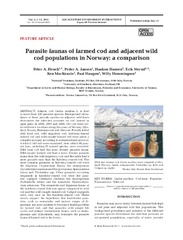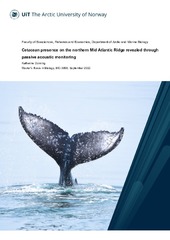Institutt for arktisk og marin biologi: Recent submissions
Now showing items 541-560 of 2086
-
Combined effects of temperature and fishing mortality on the Barents Sea ecosystem stability
(Journal article; Tidsskriftartikkel; Peer reviewed, 2022-07-16)Temporal variability in abundance and composition of species in marine ecosystems results from a combination of internal processes, external drivers, and stochasticity. One way to explore the temporal variability in an ecosystem is through temporal stability, measured using the inverse of the coefficient of variation for biomass of single species. The effect of temperature and fisheries on the ... -
Marine mammal hotspots across the circumpolar Arctic
(Journal article; Tidsskriftartikkel; Peer reviewed, 2022-05-11)Aim: Identify hotspots and areas of high species richness for Arctic marine mammals.<p><p> Location: Circumpolar Arctic. <p>Methods: A total of 2115 biologging devices were deployed on marine mammals from 13 species in the Arctic from 2005 to 2019. Getis-Ord Gi* hotspots were calculated based on the number of individuals in grid cells for each species and for phyloge-netic groups (nine pinnipeds, ... -
The Influence of Sea Ice Cover and Atlantic Water Advection on Annual Particle Export North of Svalbard
(Journal article; Tidsskriftartikkel; Peer reviewed, 2022-10-04)The Arctic Ocean north of Svalbard has recently experienced large sea ice losses and the increasing prominence of Atlantic water (AW) advection. To investigate the impact of these ongoing changes on annual particle export, two moorings with sequential sediment traps were deployed in ice-free and seasonally ice-covered waters on the shelf north (NSv) and east (ESv) of Svalbard, collecting sinking ... -
Evidence of temperature control on mesopelagic fish and zooplankton communities at high latitudes
(Journal article; Tidsskriftartikkel; Peer reviewed, 2022-09-06)Across temperate and equatorial oceans, a diverse community of fish and zooplankton occupies the mesopelagic zone, where they are detectable as sound-scattering layers. At high latitudes, extreme day-night light cycles may limit the range of some species, while at lower latitudes communities are structured by dynamic ocean processes, such as temperature. Using acoustic and oceanographic ... -
Parasitic plant small RNA analyses unveil parasite- specific signatures of microRNA retention, loss, and gain
(Journal article; Tidsskriftartikkel; Peer reviewed, 2022-07-21)Parasitism is a successful life strategy that has evolved independently in several families of vascular plants. The genera Cuscuta and Orobanche represent examples of the two profoundly different groups of parasites: one parasitizing host shoots and the other infecting host roots. In this study, we sequenced and described the overall repertoire of small RNAs from Cuscuta campestris and Orobanche ... -
Genetic stock identification reveals greater use of an oceanic feeding ground around the Faroe Islands by multi-sea winter Atlantic salmon, with variation in use across reporting groups
(Journal article; Tidsskriftartikkel; Peer reviewed, 2022-10-18)While it is known that the oceans around the Faroe Islands support an Atlantic salmon (Salmo salar) feeding ground, the relative use of this resource by different age classes and populations remains largely unexplored. Using genetic stock identification and run–reconstruction modelling, we observed a consistent pattern whereby the proportion of multi-sea winter salmon (MSW—fish that have spent ... -
Parasite faunas of farmed cod and adjacent wild cod populations in Norway: a comparison
(Journal article; Tidsskriftartikkel; Peer reviewed, 2011-07-14)Atlantic cod Gadus morhua L. is host to more than 120 parasite species. Background abundance of these parasite species on adjacent wild hosts determines the infection pressure on cod farmed in open pens. In 2006, 2007 and 2008, 343 cod were collected from 4 locations along the coast of Norway: Øksfjord, Kvarøy, Brønnøysund and Ålesund. Freshly killed wild local cod, wild migratory cod, hatchery-reared ... -
The complete mitochondrial genome of the southern calanoid copepod Calanus simillimus Giesbrecht, 1902
(Journal article; Tidsskriftartikkel; Peer reviewed, 2022-07-07)The complete mitochondrial genome of Calanus simillimus is 27,876 bp in length (GenBank accession OK500294) and containing 13 protein-coding genes (PCGs), 2 rRNA genes, 22 transfer RNA genes. The gene order is novel compared to other Calanus species and copepods with sequenced mitogenomes. Phylogenetic analysis suggests that C. simillimus represent a fourth group within Calanus genus in addition ... -
Consequences of COVID-19 on the Reindeer Husbandry in Norway: a Pilot Study Among Management Staff and Herders
(Journal article; Tidsskriftartikkel; Peer reviewed, 2022-05-02)The outbreak of COVID-19 has had an enormous impact on most of society. The most effective measure to prevent the spread has been reducing mobility, which is especially problematic for pastoralists relying on mobility to follow the movement of their livestock. We investigated to what degree Norwegian reindeer husbandry and the reindeer husbandry management system are affected by COVID-19 and government ... -
Spatio-temporal Diptera visitation to Silene acaulis flowers studied with time-lapse cameras in Svalbard and Greenland
(Master thesis; Mastergradsoppgave, 2022-08-15)Flower visitation by flying arthropods has mainly been studied by direct human observation, which usually neglects seasonal development of flower abundance even though this is known to be important for visitor dynamics and match between trophic levels. In the present study, the arthropod visitor community focusing on Diptera was investigated on the cushion plant Silene acaulis (L.) Jacq. in relation ... -
Native Chilean Fruits and the Effects of Their Functional Compounds on Human Health
(Chapter; Bokkapittel, 2017-03-01)In recent years, there has been great interest in the nutraceutical compounds of fruits from native Chilean plant species. In this context, fruits of Amomyrtus meli (Meli), Aristotelia chilensis (Maqui), Berberis microphylla (Calafate), Luma apiculata (Arrayán), Luma chequén (Chequén), and Ugni molinae (Murtilla) growing predominantly in Chilean forests have been studied. This chapter has compiled ... -
Surface chlorophyll anomalies induced by mesoscale eddy- wind interactions in the northern Norwegian Sea
(Journal article; Tidsskriftartikkel; Peer reviewed, 2022-09-29)The substantial productivity of the northern Norwegian Sea is closely related to its strong mesoscale eddy activity, but how eddies affect phytoplankton biomass levels in the upper ocean through horizontal and vertical transportmixing has not been well quantified. To assess mesoscale eddy induced ocean surface chlorophyll-a concentration (CHL) anomalies and modulation of eddywind interactions in ... -
Cetacean presence on the northern Mid Atlantic Ridge revealed through passive acoustic monitoring
(Master thesis; Mastergradsoppgave, 2022-09-16)Cetaceans are known to utilise the Mid-Atlantic Ridge, a key topographical feature in the Atlantic Ocean, for migratory and feeding purposes. Passive acoustic monitoring was used over a one-year period (2007/2008) to identify cetacean vocalisations that occurred on a location near the Charlie Gibbs Fracture Zone. Using species-specific vocalisations that have previously been documented in the North ... -
Spatio-Temporal Variability of Suspended Particulate Matter in a High-Arctic Estuary (Adventfjorden, Svalbard) Using Sentinel-2 Time-Series
(Journal article; Tidsskriftartikkel; Peer reviewed, 2022-06-29)Arctic coasts, which feature land-ocean transport of freshwater, sediments, and other terrestrial material, are impacted by climate change, including increased temperatures, melting glaciers, changes in precipitation and runoff. These trends are assumed to affect productivity in fjordic estuaries. However, the spatial extent and temporal variation of the freshwater-driven darkening of fjords remain ... -
Impact of the COVID-19 pandemic on human-nature relations in a remote nature-based tourism destination
(Journal article; Tidsskriftartikkel; Peer reviewed, 2022-09-29)Tourism and nature-based recreation has changed dramatically during the COVID-19 pandemic. Travel restrictions caused sharp declines in visitation numbers, particularly in remote areas, such as northern Norway. In addition, the pandemic may have altered human-nature relationships by changing visitor behaviour and preferences. We studied visitor numbers and behaviour in northern Norway, based on ... -
Impact of climatic change on alpine ecosystems: inference and prediction
(Journal article; Tidsskriftartikkel; Peer reviewed, 2011-01-26)Alpine ecosystems will be greatly impacted by climatic change, but other factors, such as land use and invasive species, are likely to play an important role too. Climate can influence ecosystems at several levels. We describe some of them, stressing methodological approaches and available data. Climate can modify species phenology, such as flowering date of plants and hatching date in insects. It ... -
Life history adaptations to fluctuating environments: Combined effects of demographic buffering and lability
(Journal article; Tidsskriftartikkel; Peer reviewed, 2022-08-20)Demographic buffering and lability have been identified as adaptive strategies to optimise fitness in a fluctuating environment. These are not mutually exclusive, however, we lack efficient methods to measure their relative importance for a given life history. Here, we decompose the stochastic growth rate (fitness) into components arising from nonlinear responses and variance–covariance of demographic ... -
Spatial occurrence and abundance of marine zooplankton in Northeast Greenland
(Journal article; Tidsskriftartikkel; Peer reviewed, 2022-08-20)We present a large-scale survey of mesozooplankton (size range 0.2–20 mm) across coastal, shelf, and slope locations in Northeast Greenland (latitudes 74–79° N, August 2015 and September 2017). Our study is centred on the Video Plankton Recorder (VPR) for non-invasive in situ observations of taxa distribution and abundance while simultaneously recording oceanographic profiles. A modified WP-2 plankton ... -
Importance of bacteria and protozooplankton for faecal pellet degradation
(Journal article; Tidsskriftartikkel; Peer reviewed, 2014)The degradation mechanisms of faecal pellets are still poorly understood, although they determine their contribution to vertical fluxes of carbon. The aim of this study was to attempt to understand the microbial (bacteria and protozooplankton) degradation of faecal pellets by measuring the faecal pellet carbon-specific degradation rate (FP-CSD) as an indicator of pellet degradation. ‘In situ’ and ... -
Marine mammal consumption and fisheries removals in the Nordic and Barents Seas
(Journal article; Tidsskriftartikkel; Peer reviewed, 2022-05-28)In this study, we assess prey consumption by the marine mammal community in the northeast Atlantic [including 21 taxa, across three regions: (I) the Icelandic shelf, Denmark Strait, and Iceland Sea (ICE); (II) the Greenland and Norwegian Seas (GN); and (III) the Barents Sea (BS)], and compare mammal requirements with removals by fisheries. To determine prey needs, estimates of energetic requirements ...


 English
English norsk
norsk


















